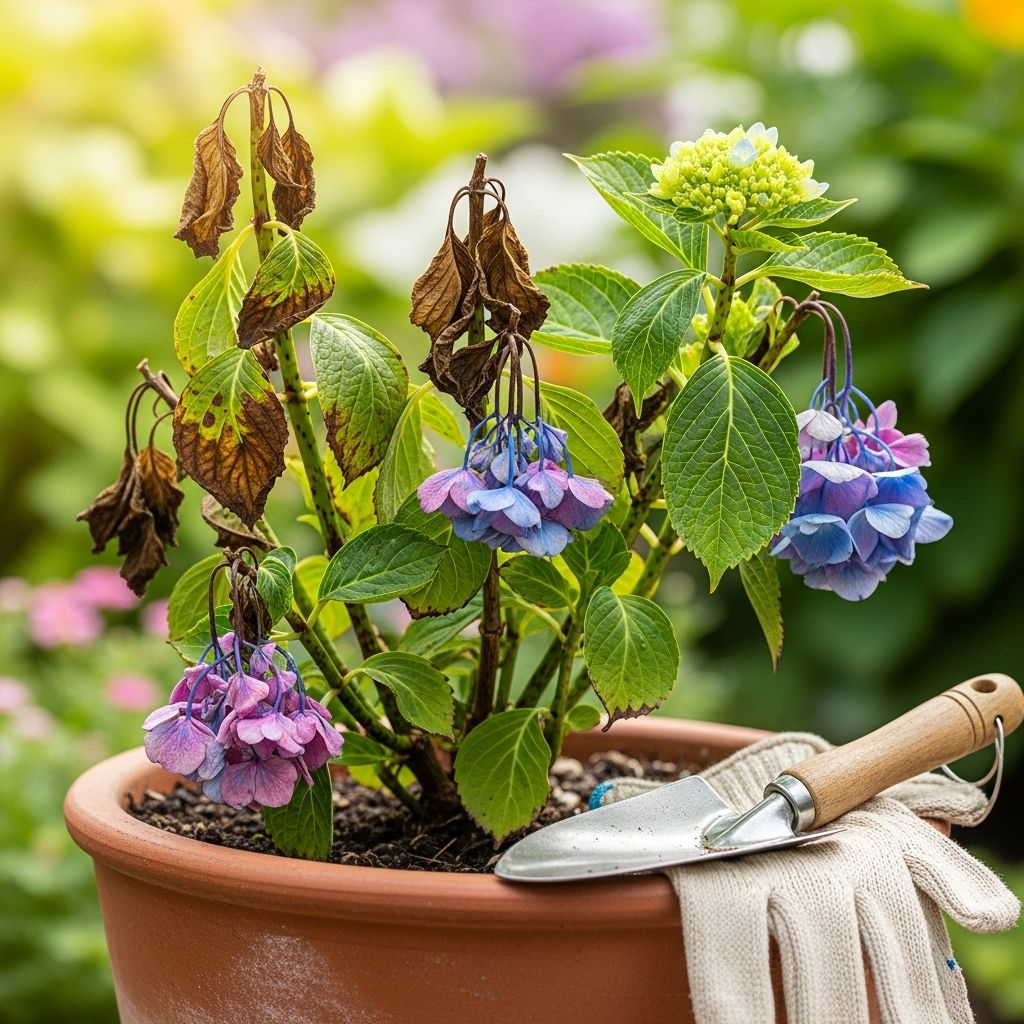How To Revive A Dying Hydrangea: 6 Essential Steps For Revival
Unlock expert strategies to bring your wilting or sad hydrangea shrubs back to vibrant health and stunning beauty.

Image: HearthJunction Design Team
Reviving Dying Hydrangeas: Comprehensive Steps to Bring Your Plants Back
Hydrangeas, celebrated for their globe-like blossoms and stunning foliage, can occasionally suffer from wilting, drooping, or even apparent death. Whether you’re a seasoned gardener or just starting your hydrangea journey, understanding the causes and solutions for declining hydrangeas is essential to maintaining their vibrant presence in your landscape. This in-depth guide explores common reasons hydrangeas struggle, effective revival techniques, preventive care, and answers to frequently asked questions.
Why Is My Hydrangea Dying? Common Causes
Before taking action, it’s crucial to identify what’s causing your hydrangea’s distress. Multiple factors can contribute to a hydrangea’s decline:
- Improper watering – too much or too little moisture.
- Poor soil conditions – nutrient deficiencies or incorrect pH.
- Excessive sunlight or heat stress.
- Improper fertilization.
- Pest or disease issues.
- Transplant shock.
Wilting, leaf browning, scorched edges, drooping stems, and fewer blooms all signal underlying problems that can be addressed with targeted solutions.
Step-By-Step: How to Revive a Dying Hydrangea
Follow these practical steps to assess and rejuvenate your struggling hydrangea:
1. Evaluate Watering Practices
- Check soil moisture by inserting your finger 2 inches into the soil. It should feel evenly damp, not soggy or bone-dry.
- Water deeply and less frequently, especially in the morning, to encourage strong root growth.
- For drooping or wilted plants, a deep soak can often revive them within hours.
- For indoor potted hydrangeas, ensure the container has adequate drainage.
2. Inspect Sunlight and Heat Exposure
- Hydrangeas thrive in bright but indirect sunlight. Too much direct afternoon sun may scorch leaves and flowers.
- Consider relocating potted plants or providing shade for garden hydrangeas during the hottest part of the day.
3. Perform a Soil Test
- Test soil for pH and nutrient content before fertilizing. Hydrangeas prefer a pH between 5.5 and 6.5, but some varieties change bloom color depending on acidity.
- Correct deficiencies with an appropriate fertilizer if indicated by the soil test.
- If blooms are lackluster, a spring feeding may help, but avoid overfertilization which can lead to salt buildup and root burn.
4. Remove Dead or Damaged Growth
- Carefully prune away any dead leaves, stems, or flowers. This allows the plant to redirect energy to healthy growth.
- Pruning also improves air circulation, reducing risk of disease.
5. Rehydrate Severely Wilted Plants
For hydrangeas suffering serious dehydration:
- Remove all dead or entirely brown tissue.
- Soak the root ball in a bucket or tub of water for several hours or overnight.
- For a rapid recovery boost, cover the wilted plant loosely with a plastic bag to create a humid microclimate while it recovers.
- Monitor for improvement within 24 hours; new turgidity and perked-up leaves may signal recovery.
6. Address Pest or Disease Issues
- Look for signs of fungal spots, powdery mildew, or insect infestations.
- Treat as needed with targeted organic or chemical controls.
Pro Tips for Speedy Hydrangea Recovery
- Mulch around the base with 2-3 inches of organic material to retain moisture and regulate soil temperature.
- Use a gentle spray setting when watering to avoid compacting soil or damaging roots.
- If recovering from transplant shock, ensure the plant is stable and avoid fertilizing until active new growth appears.
- For container plants, repot in fresh soil if roots appear crowded or rot is present.
Soil Solutions: Boosting Hydrangea Health from Below
The foundation of every healthy hydrangea is the soil beneath. Here’s how to optimize soil for hydrangea revival and ongoing vigor:
- Good Drainage: Hydrangeas dislike standing water. Amend heavy clay or compacted soils with compost or perlite for better drainage.
- Alkalinity Adjustment: Some gardeners have success with a weak baking soda solution to slightly increase alkalinity, encouraging larger, more vibrant blooms.
- Organic Amendments: Incorporate well-rotted manure or leaf mold to boost both moisture retention and nutrient content.
Preventing Common Hydrangea Problems
Regular care can help you avoid the root causes of hydrangea decline. Key prevention tips:
- Water consistently, especially during hot or dry periods—avoid letting the soil dry out completely.
- Mulch and shade to prevent heat stress and conserve moisture.
- Monitor for pests and diseases; remove affected material promptly.
- Feed only as needed, based on a soil test.
Recovery Success Stories
Hydrangeas respond quickly to corrective action:
- Within a week of addressing underlying issues, gardeners often see new foliage, perkier stems, and healthier buds.
- Plants previously considered beyond hope have been revived to produce even more abundant blooms in the following season.
Table: Common Hydrangea Problems and Solutions
| Problem | Symptoms | Solution |
|---|---|---|
| Underwatering | Wilting, dry leaves, stunted growth | Deep soak, regulate watering |
| Overwatering | Yellow leaves, root rot, soggy soil | Improve drainage, reduce watering |
| Insufficient nutrients | Pale foliage, poor blooming | Fertilize after soil test |
| Heat stress | Crispy leaf edges, drooping | Provide shade, mulch |
| Pest/disease | Spots, powdery mildew, sticky residue | Remove affected parts, use controls |
| Improper pruning | No blooms, weak stems | Prune at correct time; avoid heavy pruning |
Frequently Asked Questions (FAQs)
Q: Why does my hydrangea wilt in the afternoon but perk up overnight?
A: Afternoon wilting is often caused by heat and sun stress. As temperatures drop overnight, the plant recovers. Consistent mulching and providing some afternoon shade can minimize these swings.
Q: Should I fertilize a struggling hydrangea?
A: Only after a soil test. Overfertilizing can worsen the problem. If needed, use a balanced, slow-release fertilizer in spring.
Q: Can I revive a hydrangea with all brown leaves?
A: Yes, if the stem is still green and flexible, the plant can rebound. Remove all dead tissue, water thoroughly, and provide shade while it recovers.
Q: How do I know if my hydrangea is getting too much water?
A: Persistent soggy soil, yellow leaves, and a musty smell indicate overwatering. Improve drainage and allow the soil to dry slightly between waterings.
Q: What’s the fastest way to revive a wilted hydrangea?
A: Soak the root ball thoroughly and use a plastic bag to create humidity for rapid recovery. Most hydrangeas perk up noticeably within 24 hours.
Simple Extra Tips for Thriving Hydrangeas
- Display cut hydrangea stems in water immediately; submerge blooms for 2–4 hours to revive wilted flowers.
- Monitor potted plants particularly closely, as they dry out faster and are more sensitive to environmental changes.
- Regularly check for disease and pests—early intervention is key.
- Incorporate baking soda occasionally for larger blooms, but do not overapply.
Final Thoughts
Even the saddest hydrangea can make a dramatic comeback with the right care. Start by diagnosing the cause, address soil and water issues, and practice ongoing preventive maintenance. Whether grown in the ground or in containers, well-cared-for hydrangeas reward you with lush foliage and breathtaking flowers year after year. Happy gardening!
References
Read full bio of Shinta












